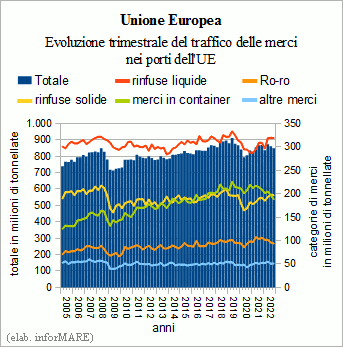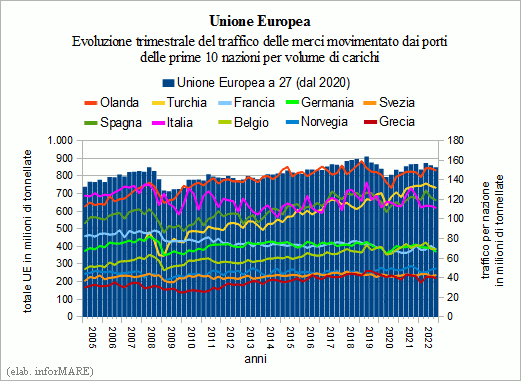
In the fourth quarter of 2022, according to data released by Eurostat, EU ports to 27 handled a total of 849.0 million tonnes of goods, down -2.2% percent on the corresponding period of the previous year. Just as from the second quarter of 2021, during the entire recovery period compared with the previous significant decrease in the volumes of loads coinciding with the global spread of the pandemic of Covid-19, also in the period October-December of 2022 to be in growth were the bulk of the bulk of the European Union's ports : in particular, the bulk of the bulk of the bulk of the bulk of the bulk of the bulk of the bulk

amounted to 318.9 million tonnes (+ 3.4%) and solid bulk reinfuses at 196.7 million tonnes (+ 2.8%). In the field of miscellaneous goods, instead, the trend of degrowth in the second quarter of 2022 has been accentuated : in the last quarter of last year, containerized goods stood at 188.2 million tonnes (-10.0%), the rotatable ones at 93.8 million tonnes (-11.7%) and the other goods 51.2 million tonnes (-2.6%).
According to data released by the European statistics institute, in the last quarter of 2022, traffic in Italian ports was 111.5 million tonnes, down -10.1% percent over the same period in 2021. It is necessary to point out that, according to the figures made by the Association of Italian Ports as a result of those communicated to Assoports by the individual Italian Port System Authority, in the fourth quarter of last year, Italian ports have handled 117.6 million tonnes (-2.9%), or 6.1 million tonnes more than the Eurostat figure. In the statistics of the European institute even the data referred to other European nations are almost never aligned with those reported by the statistical institutes of the individual nations, but rarely do the figures differ as in the specific case of the Italian ports. By way of example, by comparing ISTAT, the Italian statistics institute, and referring to the annual data of 2018, 2019, 2020 and 2021, the latest available from Eurostat, Istat and Assoports, according to the European institute. in 2018, Italian ports handled 490.8 million tonnes of cargo, or 11.1 million tonnes less than Istat and 5.8 million tonnes less than Assoports reported. In the following years, the comparison between the Eurostat data and those of Istat, although markedly different, is similar, while the gap with those of Assoports appreciates appreciably : Eurostat registers 499.2 million in traffic for 2019. tonnes handled by Italian ports, 8.8 million less than Istat said and 9.9 million more than in Assoports ; for Eurostat in 2020, the figure was 459.8 million tonnes, 9.8 million less than Istat says and 16.6 million tonnes more than the figures released by Assoports ; in 2021 the Eurostat figure is 492.9 million tonnes, 8.7 million less than in Istat and 12.1 million tonnes more compared to Assoports. The gap in sign in 2022, the year compared to which Istat has not yet released data : for Eurostat last year, Italian ports totalled 450.2 million tonnes of cargo while Assoports accounted for 490.1 million tonnes of goods. tonnes, which is a difference of well 39.9 million tonnes. It seems that if until 2018 (because even in previous years the comparisons were similar) Eurostat underestimated the traffic handled by Italian ports, according to Istat it continued to do in the 2019-2021 three-year period, while Assoports said in the year. period has markedly overestimated it to return to underestimate it greatly in 2022 in the notice of the Association of Italian Ports. If it is generally underestimated, it is good that the Italian portuality will make efforts to remove this underestimation in European Parliament. 
